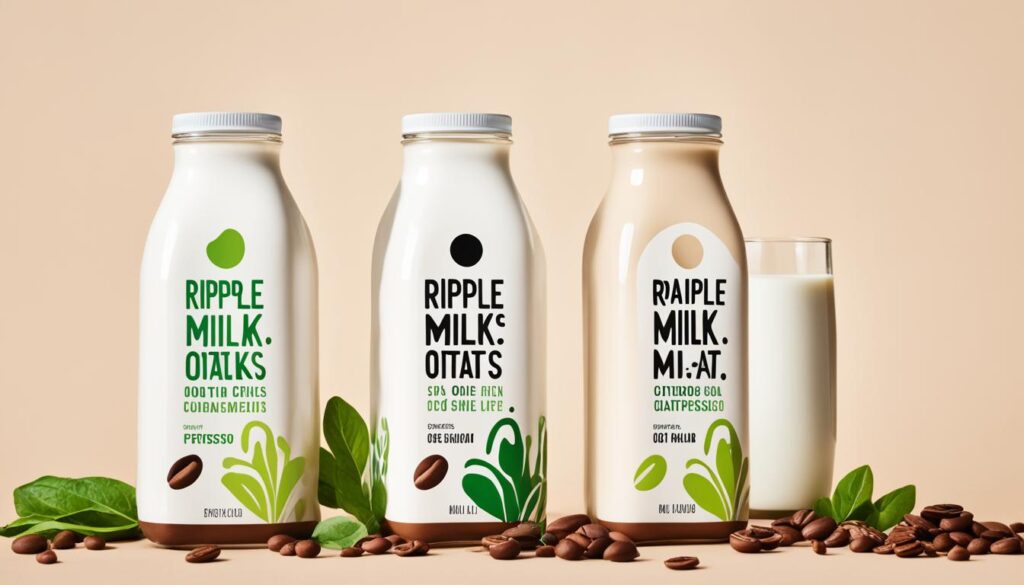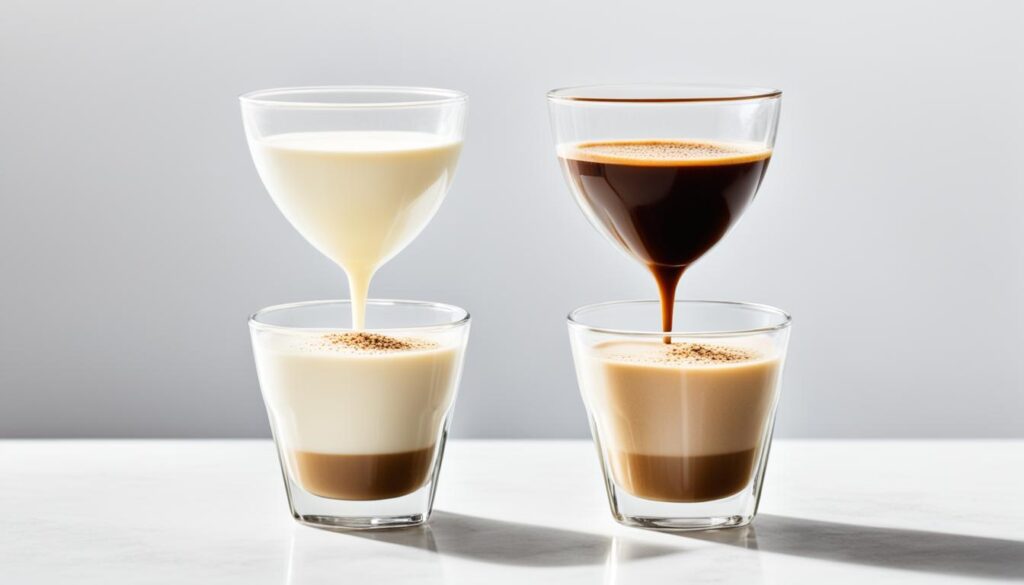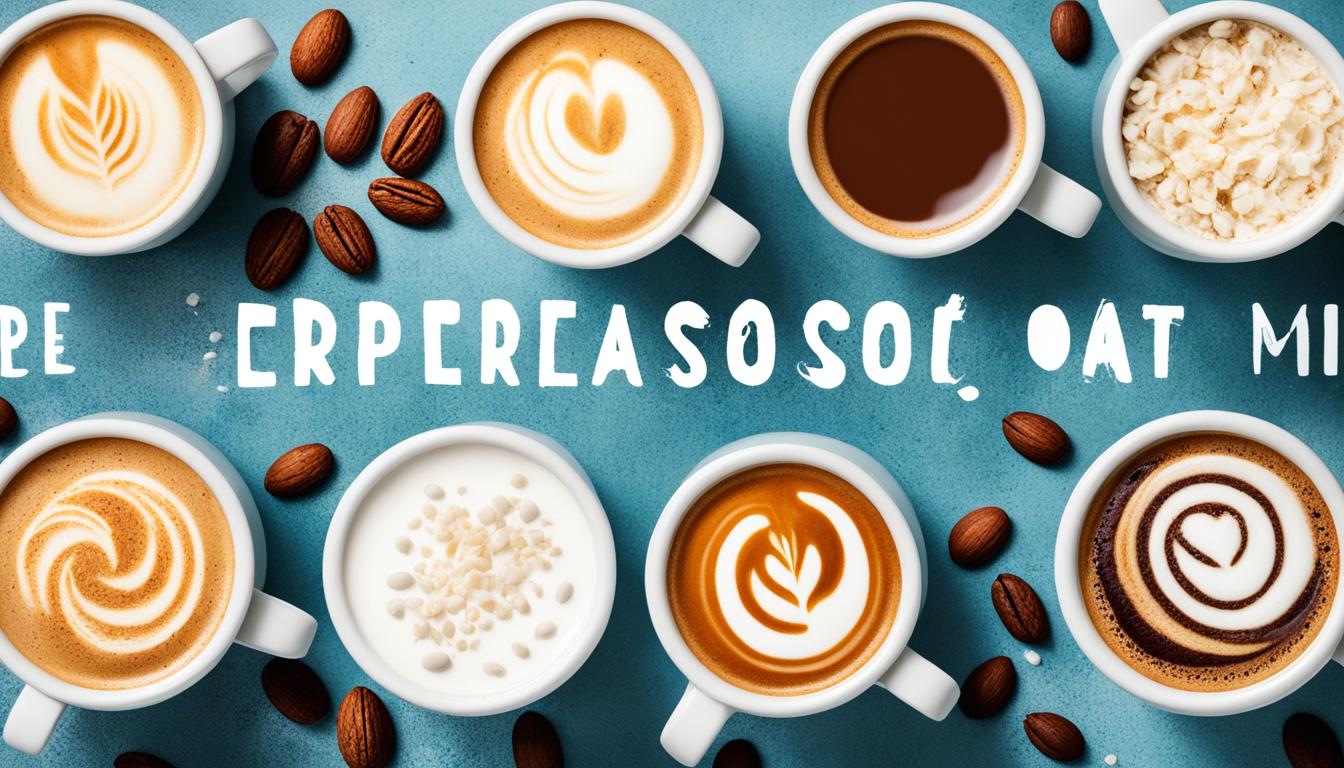Swapping almond milk for whole or 2% in cereal or in pancake batter is one thing, but when it comes to espresso drinks, finding the best milk alternative can be a challenge. In a side-by-side tasting session conducted by a panel of coffee professionals, a selection of commonly available nondairy milks were put to the test in lattes and cappuccinos. The panel evaluated the milks based on foam texture, flavor, sweetness, and overall preference. The top-rated milk alternatives for espresso drinks were Ripple, Milkadamia, and Oatly.
Key Takeaways:
- Ripple, Milkadamia, and Oatly emerged as the top milk alternatives for espresso drinks.
- These milk alternatives were evaluated based on foam texture, flavor, sweetness, and overall preference.
- Swapping almond milk for espresso drinks is not as straightforward as it may seem.
- Plant-based milk options offer viable dairy-free alternatives for coffee beverages.
- Finding the best milk alternative for espresso drinks requires considering foam texture, flavor, and the ability to create latte art.
Now, let’s dive deeper into why these milk alternatives for espresso drinks are gaining popularity and how they stack up against traditional dairy milk options.
Why Milk Alternatives for Espresso Drinks?
With more people opting for plant-based beverages, the demand for milk alternatives for espresso drinks is growing. Not only are these alternatives better for the environment, but they may also offer health benefits. However, it is important to find milk alternatives that can steam well, taste good, and maintain the ability to create latte art. Concerns such as thin foam, “plant-y” taste, and up-charges at cafes have informed the criteria for judging the milk alternatives. Foam texture, flavor, sweetness, and overall preference were the qualities considered in the evaluation of the milk alternatives.
When it comes to enjoying a delicious cup of espresso, the choice of milk plays a crucial role in creating the perfect balance of flavor and texture. While traditional dairy milk has been the go-to option for many years, an increasing number of people are now turning to alternative milks for their espresso drinks. Whether you follow a vegan lifestyle, have dietary restrictions, or simply prefer plant-based options, there are plenty of vegan milk alternatives for coffee that can deliver a satisfying and creamy experience.
Vegan milk options for coffee offer a range of choices that cater to different taste preferences and dietary needs. From dairy substitutes made from nuts to plant-based options derived from oats and soy, there is no shortage of options when it comes to finding a dairy-free alternative for your daily caffeine fix.
One of the primary reasons for choosing milk alternatives is the environmental impact. Traditional dairy farming has a significant carbon footprint, while plant-based alternatives generally require fewer resources and produce lower greenhouse gas emissions. By opting for dairy substitutes for coffee, you can reduce your ecological footprint and contribute to a more sustainable future.
Moreover, milk alternatives can offer health benefits to individuals with lactose intolerance or dairy allergies. These dairy-free options allow you to enjoy your espresso drinks without any discomfort or adverse reactions. Additionally, some alternative milks are fortified with essential nutrients like calcium and vitamin D, making them a nutritious choice to incorporate into your diet.
When selecting milk alternatives for espresso drinks, it is important to consider factors such as foam texture, flavor, sweetness, and overall preference. The ability to create latte art is also crucial for those who appreciate the visual appeal of their coffee creations. The evaluation of milk alternatives involved rigorous scrutiny of these qualities to ensure that the chosen options deliver both on taste and presentation.
Our goal was to find milk alternatives that not only mimicked the creamy mouthfeel of traditional milk but also added their own unique flavors and textures to elevate the espresso experience. We understand the importance of a well-made, dairy-free latte and aimed to find the best milk alternatives that could meet those expectations.
With the rising popularity of vegan and dairy-free options, baristas and coffee enthusiasts have embraced the challenge of creating exquisite espresso drinks using alternative milks. Many cafes and specialty coffee shops now offer a variety of milk alternatives for coffee, ranging from almond milk and oat milk to coconut milk and soy milk. This wide array of choices allows individuals to customize their espresso drinks according to their preferences and dietary requirements.
In the following section, we will delve deeper into the testing process and reveal the top milk alternatives for espresso drinks that emerged from the evaluation. Through an expert analysis and sensory evaluation, we aimed to find the best milk alternatives that not only satisfy the taste buds but also elevate the espresso experience to new heights.
The Testing Process
Our evaluation of popular non-dairy milks for espresso drinks involved a rigorous and systematic testing process. We assembled a panel of five coffee professionals, each with extensive sensory-analysis training, to conduct the evaluation. Our goal was to identify the top milk alternatives for lattes and cappuccinos, considering factors such as foam texture, flavor, sweetness, and overall ranking within each category.
We tested a total of 11 nondairy milks, carefully selected for their popularity and availability in the market. All milks were evaluated using a consistent espresso recipe to ensure fairness and accuracy in our comparisons. To assess foam texture and quality, we used both lattes and cappuccinos as the base drinks for our evaluations.
Throughout the testing process, our panel followed the “rule of silent work.” This means that after each drink was prepared and served, we refrained from discussing our observations until everyone had tasted and rated the milk alternative. This approach ensured unbiased assessments and prevented any influence from individual opinions.
Additionally, we poured each drink to create classic latte art designs, such as rosetta and monk’s head. This allowed us to observe the pouring characteristics and latte art potential of each milk alternative, further adding to the comprehensive nature of our evaluation.
We also considered the flavor profiles of the milk alternatives, assessing their ability to blend harmoniously with espresso and provide a pleasant taste experience. To ensure the accuracy of our flavor assessment, we sampled each drink as soon as it was completed, assessing its flavor at different temperatures.
Our evaluation process yielded valuable insights into the performance of popular non-dairy milks for espresso drinks. Through careful analysis and comparison, we determined the top milk alternatives for lattes and cappuccinos that not only meet the standards for foam texture and flavor but also deliver the ability to create beautiful latte art.
The Winners: Ripple, Milkadamia, and Oatly
In the evaluation of the milk alternatives, Ripple, Milkadamia, and Oatly emerged as the top choices. These plant-based milks have proven to be the best options for espresso drinks, offering excellent foam texture, delightful flavors, and the ability to create beautiful latte art.
Ripple, a “barista series” milk made from pea protein, stood out with its outstanding foam texture. It earned the highest marks in this category, making it a great choice for those seeking a creamy and frothy espresso experience.
Oatly, known for its high-quality oat milk, ranked second in foam consistency and impressed tasters with its “sweet” and “milky neutral” taste. It is a popular choice among coffee lovers who prefer a subtle and balanced flavor profile.
Milkadamia, made from macadamia nuts, tied with Oatly for best overall flavor. It delighted the panel with its unique “cereal milk” and “vanilla extract” flavors, providing a tasty alternative for those who enjoy a touch of sweetness in their lattes.
These top milk alternatives for espresso drinks have proven to froth well, pour smoothly, and deliver satisfying flavor profiles. They provide a perfect solution for individuals looking for dairy-free and plant-based options that can rival the traditional dairy milk experience.

- Ripple
- Milkadamia
- Oatly
The Classics: Whole Milk and 2% Milk
In the realm of espresso drinks, traditional dairy milks have long been the go-to choices for coffee enthusiasts. Let’s explore the two classics: whole milk and 2% milk.
Whole Milk
Whole milk has garnered a reputation as the gold standard for making lattes. Its creamy texture and natural sweetness complement the espresso flavors perfectly. During the tasting session, whole milk stood out and received the highest rating for both foam texture and overall preference.
Rating for Whole Milk:
| Criteria | Rating |
|---|---|
| Foam Texture | 5/5 |
| Overall Preference | 5/5 |
2% Milk
2% milk is another commonly used option for espresso drinks. While it froths well and allows for latte art, it falls short in flavor compared to whole milk. Some testers noted that 2% milk tends to be watery and lacks the richness and creaminess found in whole milk.
Rating for 2% Milk:
| Criteria | Rating |
|---|---|
| Foam Texture | 4/5 |
| Overall Preference | 3/5 |
Although whole milk outshines 2% milk in terms of flavor and overall preference, both options have their merits in the world of espresso drinks.

Exploring Other Options: Lactaid, Oat Milk, and Macadamia Nut Milk
In our evaluation of milk alternatives for espresso drinks, we discovered some unexpected contenders that offer viable options for those seeking dairy-free and lactose-free alternatives. Let’s explore Lactaid, Oat Milk, and Macadamia Nut Milk.
Lactaid, a lactose-free milk, proved to be a surprising find. It matched the qualities of whole milk, providing a creamy and sweet taste that closely resembles traditional dairy milk. Lactaid’s ability to froth well and create latte art makes it a great option for espresso lovers who are lactose intolerant or prefer to avoid dairy.
Oat Milk may not have been the top choice in terms of taste, but it displayed impressive frothing and pouring abilities similar to whole milk. Oat milk’s creamy texture and ability to complement the flavor of espresso make it a worthy contender for those looking for plant-based alternatives.
Macadamia Nut Milk stood out with its rich flavor and smooth mouthfeel. Made from macadamia nuts, this milk alternative adds a unique and indulgent twist to your espresso drinks. Its ability to froth well makes it an appealing option for those seeking a decadent dairy-free experience.
These options provide delicious alternatives for individuals with dietary restrictions or preferences. Whether you’re lactose-intolerant, following a plant-based diet, or simply looking to try something different, Lactaid, Oat Milk, and Macadamia Nut Milk offer you the opportunity to enjoy your espresso drinks without compromising on taste or quality.

Comparing Milk Alternatives:
| Milk Alternative | Foam Texture | Flavor | Latte Art |
|---|---|---|---|
| Lactaid | Smooth and creamy | Sweet | Good |
| Oat Milk | Creamy and frothy | Neutral | Good |
| Macadamia Nut Milk | Smooth and velvety | Nutty and rich | Good |
As you can see from the table above, these milk alternatives offer different characteristics that cater to various taste preferences and dietary needs. Whether you’re looking for a sweeter option like Lactaid or the indulgence of Macadamia Nut Milk, you can find a dairy-free alternative that meets your requirements.
Nut-Based Alternatives: Almond Milk and Cashew Milk
When it comes to nut milk alternatives for espresso drinks, almond milk and cashew milk are two popular choices. Let’s take a closer look at how these nut-based alternatives performed in our evaluation.
Almond Milk
Almond milk, commonly found at many cafes, proved to be a viable option for dairy-free espresso drinks. With some practice, almond milk can froth adequately, allowing you to create latte art. However, one drawback that some testers found was its strong almond flavor, which might not appeal to everyone’s taste buds. Nevertheless, if you enjoy the unique flavor of almonds in your coffee, almond milk can be a fantastic alternative.
Cashew Milk
Cashew milk, on the other hand, did not perform as well in our evaluation. While it frothed well despite its thin consistency, cashew milk lacked in both texture and taste. Testers found it to be bland and oily, which might not give you the rich and creamy latte experience you desire. When seeking a nut-based alternative for your espresso drinks, cashew milk may not be the top choice.
Despite their individual strengths and weaknesses, both almond milk and cashew milk offer dairy-free alternatives for those looking to enjoy unique nutty flavors in their coffee beverages.
| Milk Alternative | Foam Texture | Flavor |
|---|---|---|
| Almond Milk | Adequate with practice | Strong almond flavor |
| Cashew Milk | Froths well | Bland and oily |
As you can see from the table above, almond milk froths adequately, but its strong almond flavor might not be to everyone’s liking. Cashew milk, on the other hand, froths well but falls short in both texture and taste.
While these nut-based alternatives may not be the top choices for espresso drinks, they still provide dairy-free options for those who enjoy their unique flavors. Whether you prefer the nuttiness of almond milk or the creamy consistency of cashew milk, both can offer a delightful twist to your daily coffee beverage.
Soy Milk and Coconut Milk: Common Alternatives
When it comes to milk alternatives for coffee, soy milk and coconut milk are two popular choices found in cafes around the world. Each of these alternatives offers unique characteristics that cater to different taste preferences. Let’s take a closer look at how soy milk and coconut milk fared in our evaluation.
Soy Milk: Silk Soy
One of the most well-known brands of soy milk is Silk Soy. This milk alternative received positive feedback for its natural sweetness and its ability to froth well. The panel appreciated the smooth texture that Silk Soy brought to their lattes. However, it was generally described as a “plain” option that didn’t stand out compared to the other milk alternatives.
“Silk Soy is a reliable choice for those who prefer a subtly sweet flavor and want a silky foam texture for their lattes.”
Coconut Milk
In contrast to soy milk, coconut milk faced some challenges during the evaluation. It struggled to foam well, resulting in a lack of creaminess in the lattes. The thin texture of coconut milk made it difficult to achieve the desired froth, which is crucial for creating latte art. As a result, coconut milk may not be the ideal choice for those seeking a rich and creamy latte experience.
“Coconut milk may not provide the desired creaminess and foamability for latte lovers who prefer a lush and velvety texture in their coffee beverages.”
While soy milk and coconut milk are both popular alternatives to dairy milk in coffee, each has its own strengths and limitations. Soy milk, like Silk Soy, offers a sweet taste and frothing ability that can satisfy many coffee enthusiasts. On the other hand, coconut milk struggles with foamability and lacks the rich texture found in other milk alternatives. Ultimately, the choice between soy milk and coconut milk boils down to personal taste and preferences.
| Milk Alternative | Strengths | Limitations |
|---|---|---|
| Soy Milk | Natural sweetness, good frothing ability | Plain flavor compared to other options |
| Coconut Milk | Lack of foamability, thin texture |
The Dark Horse: Goat Milk
Goat milk emerged as a unique alternative for espresso drinks during the evaluation. It displayed frothing capabilities and allowed for the creation of latte art. However, the distinct salty and tangy flavor of goat milk divided the opinions of the testers. While some appreciated its uniqueness, others found it off-putting. As a result, goat milk may not be the ideal choice for those seeking a traditional latte experience.
Nevertheless, the inclusion of goat milk in the evaluation opens the doors to further experimentation. There may be potential for exploring savory goat milk lattes in the future, appealing to individuals with adventurous taste palates who are looking for alternative milk options for their lattes.
The Role of Milk Alternatives in the Espresso Experience
Milk alternatives play a crucial role in providing options for those who prefer or need to avoid dairy. While dairy milk has a unique combination of fat, sugar, and protein that produces a silky and smooth microfoam texture, the top milk alternatives showcased in the evaluation were able to mimic these qualities to a certain extent. The best milk alternatives for espresso drinks offer the following benefits:
- Good foam texture: The top milk alternatives demonstrated the ability to create creamy and velvety foam, allowing for a satisfying latte or cappuccino experience.
- Pleasant flavor profiles: These milk alternatives offered a range of flavors, from nutty to sweet, enhancing the overall taste of the espresso drinks.
- Ability to create latte art: Creating latte art is an important aspect of the espresso experience. The top milk alternatives showed excellent pouring capabilities, allowing baristas to create intricate designs that add beauty to the coffee.
By choosing milk alternatives for their espresso drinks, coffee enthusiasts can enjoy the benefits of dairy-free lattes and cappuccinos without compromising on taste or texture.
“Milk alternatives offer a world of possibilities, allowing us to cater to the diverse preferences and dietary needs of our customers. With the right alternative milk, we can create delicious and visually stunning espresso drinks that satisfy even the most discerning coffee lovers.” – Barista Expert
Conclusion
In conclusion, after conducting a thorough evaluation, we have determined that the top milk alternatives for espresso drinks are Ripple, Milkadamia, and Oatly. These milk alternatives have proven to deliver excellent foam texture, satisfying flavors, and the ability to create latte art. While traditional dairy milk options like whole milk and 2% milk still hold their place as favorites due to their rich flavor and versatility in espresso drinks, the growing popularity of plant-based and dairy-free alternatives has opened up a diverse range of choices for those seeking a dairy-free coffee experience.
For those looking to enjoy a dairy-free latte or cappuccino, Ripple stands out with its “barista series” made from pea protein, which scored the highest marks for foam texture. Oatly, with its creamy and slightly sweet taste, ranked second in foam consistency and overall flavor. Milkadamia, made from macadamia nuts, also impressed with its unique flavor profiles and tied with Oatly for the best overall flavor.
With the demand for plant-based and dairy-free options on the rise, these milk alternatives provide viable choices for espresso enthusiasts. Whether you have dietary restrictions, environmental concerns, or simply prefer the taste of alternative milks, Ripple, Milkadamia, and Oatly have shown that they can deliver a delightful coffee experience without compromising on texture, taste, and aesthetic appeal. Cheers to the top choices for milk alternatives!
